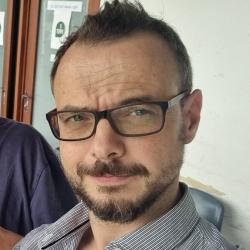
Gamazo Rusnac, Pablo
Research interests
1) Surface and groundwater hydrology: Monitoring, modelling and management tools.2) Development of codes for numerical models of hydrodynamic and transport phenomena
Working area
1) Surface and groundwater hydrology: Monitoring, modelling and management tools.The availability of water resources and their quality is one of the most important problems at a global level. Water, in addition to being necessary to sustain life, is a limiting factor for the development of human activities and the correct functioning of ecosystems. Hydrological and hydraulic mathematical modelling of both surface and underground water bodies is an essential tool for the correct management of these resources, their sustainable exploitation, the understanding of the dynamics of extreme events (floods and droughts) and for evaluating mitigation measures. In relation to groundwater, we work on the development of models for the management of aquifers and their characterization through hydrometric instruments (level measurement, pumping tests) and geophysical instruments. In relation to surface hydrological modelling, we work on the development of methodologies for distributed hydrological modelling and hydrological modelling and hydraulic transit on a daily and sub-daily scale, both for agricultural and urban basins. We also address the monitoring of surface courses through the installation and operation of hydrometric instruments (level, precipitation, soil moisture sensors, Doppler gauging equipment, and particle tracking velocimetry from images). Water quality, in addition to quantity, strongly conditions the possible uses of the resource and can be affected by both anthropogenic effects and natural causes. Waterborne diseases are caused by pathogenic microorganisms present in contaminated water, including viruses, whose infectious capacity persists both in surface and groundwater, maintaining their infectious capacity for long periods and traveling great distances. In this field, we study not only the transport of viruses in groundwater and surface water, but also the influence of other contaminating agents. Agricultural activity has a significant impact on the contamination of water resources by nutrients. Excess nitrogen and phosphorus can reach water bodies, triggering algae blooms, which affect water quality, thus compromising its potability and the aquatic ecosystem. In this line, we work with models that simulate the release and transport of nutrients in water resources. On the other hand, the presence of arsenic in aquifers represents a major problem for various uses. This element, found naturally in some soils and formations, represents a risk to human health by contaminating drinking water sources. In this line, we work on the study of the mobility and presence of arsenic in groundwater, with the aim of developing actions to mitigate its impact on public health. To assess the risk of exposure and use for different water sources and contaminants, we work with techniques that allow quantifying the associated risk, such as QMRA (Quantitative Microbial Risk Assessment).
2) Development of codes for numerical models of hydrodynamic and transport phenomena
Numerical modeling of hydrodynamic and transport phenomena is of vital importance to understand the dynamics of water bodies and solve problems linked to water resources. The current use of these codes, and what is expected of them, poses a series of challenges. Improving the efficiency of the models generated with these codes in terms of execution time is undoubtedly one of the main challenges that developers face. Faster models can be more easily incorporated into continuous monitoring systems, and they strengthen calibration and analysis processes that involve stochastic variables. In recent years, manufacturers of computer graphics cards (GPU) have developed solutions adapted to the needs of the scientific market. Taking advantage of this trend, in this line of research, we develop codes linked to hydroinformatics problems in GPUs, which implies taking into account both the physical problem to be solved, as well as the numerical problem and the computing problem depending on the hardware to be used. Another of the great challenges linked to the development of hydrodynamic and transport simulation codes is the simultaneous resolution of different physical phenomena due to the interdependence that exists between the linked variables. Therefore, it is necessary to develop efficient codes capable of solving the conservation of various physical principles and being able to couple them. In this line we work on the development of codes for sediment transport in hydrological systems. Sediment transport is related to phenomena such as scour, reservoir sedimentation, erosion due to floods, dam failures, and sedimentation and erosion of river beds. In this line of research, we study the resolution of this system of equations using numerical methods on GPU, evaluating different coupling schemes and methods to efficiently simulate bed evolution and bed-fluid interaction. The study of thermo-hydrochemical (THC) phenomena in porous media also involves studying simultaneously various groups of phenomena: liquid flow and other phases, heat transport, transport of chemical species and the reactions that involve them. Within this line of research a wide variety of problems can be framed: from the study of water and solute flow in aquifers, water flows (liquid and gaseous) and the transport of contaminants in soils, to the evolution of water content and salt precipitation in concrete. The individual modeling of each of the processes that make up the THC phenomena is in general a fairly studied problem. However, when they are considered simultaneously, the interaction between them makes their modeling difficult. In this line of research we seek to advance in the coupled modeling of these phenomena. Finally, the expansion of machine learning tools has not been alien to the field of modeling hydrodynamic and transport phenomena. This is a field that we are exploring and that we believe has great development potential for our group.
Personal information
ORCID: 0000-0003-1991-3822SCOPUS: 37007452400
CVUy: see
Institution: CENUR Sede Salto - Udelar
Career at PEDECIBA
Geosciences Area
As researcher
| Motive | Start date | Minutes | |
|---|---|---|---|
| Investigador - Evaluación | Grado 3 | 21/02/2024 | View minutes |
| Investigador - Reingreso | Grado 3 | 06/05/2020 | View minutes |
| Investigador - Ingreso | Grado 3 | 20/12/2017 | View minutes |